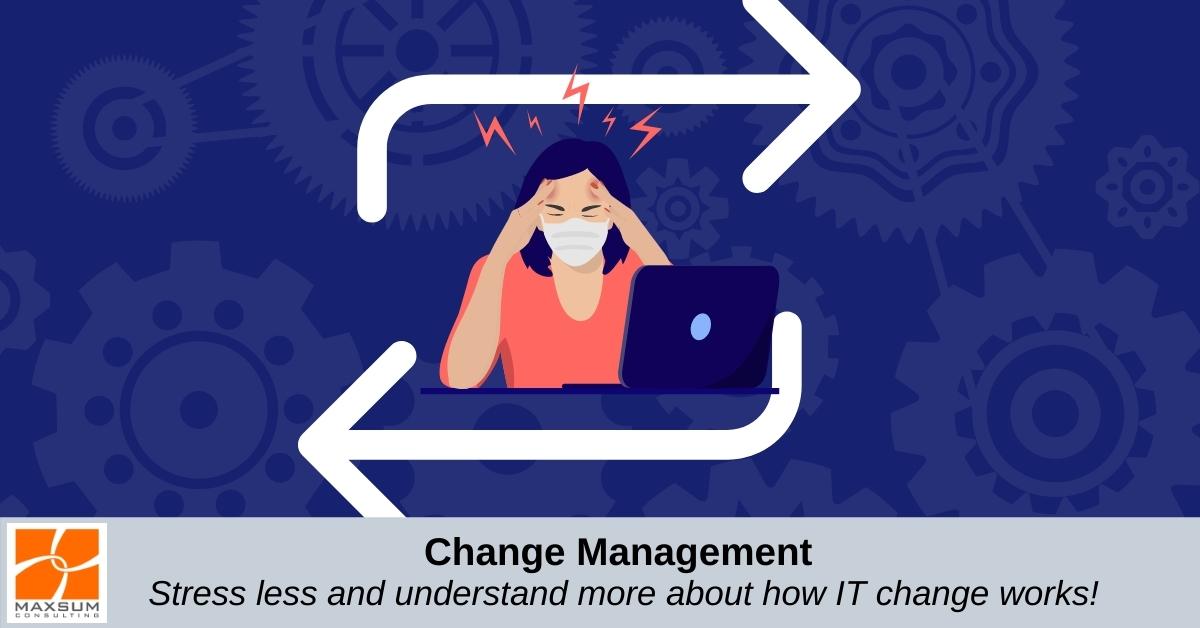Not many of us can honestly say that we welcome change. Let’s face it, change is never as good as a holiday! But understanding Change Management will help you stress less and understand more about how IT changes are made, approved and executed. Read on…
Whilst we’re usually open to exciting change we can safely anticipate a net positive outcome from – think getting your hands on that new iPhone13 – other “black box” style changes that we need but don’t necessarily understand must less control or execute ourselves, often result in anxiety, hesitation, confusion and frustration.
Why? Because IT is scary (not really…but we get it!) and we hate it when everything worked fine yesterday, but then today everything looks different!
Such is the world of IT change – sometimes there are changes you know you need and are prepared to plan and wait for. Sometimes there are changes you need made yesterday. And sometimes there are changes you didn’t even know you needed! The real question is – when the need for changes arise so fast, how can you know for sure changes are made for good reason, have been planned, considered and managed the right way?
Enter Change Management
Change Management is one of those business project buzz word that gets bandied around all the time. But in the world of IT service requests, Change Management actually has a far more practical and tangible meaning than you might expect.
The purpose of Change Management in the context of your IT systems and support services is to control and manage service requests to implement changes to IT environments or services so as to create business benefits but minimise the risk of disruption to services.
Change Management in IT consists of 4 key steps
- Record and review – A change request is received, reviewed and then classified as either a Standard, Normal or Emergency change (more on this later!)
- Assess and evaluate – Whereas Standard changes can be implemented if the request fits within the parameters of a predefined and approved process, Normal and Emergency changes are escalated directly to the Change Advisory Board (CAB). At the CAB level they are reviewed and evaluated in terms of the objective, critical success and risk factors and key performance factors.
- Approve – Once the change is assessed and evaluated and the CAB is satisfied that any risks have been mitigated, a testing and/or implementation plan is in place, as well as a roll-back plan if necessary, the change will be approved.
- Coordinate & Implement – The person who initially requested the change will be notified of the CAB’s decision, and upon their go-ahead, the requested change will then by coordinated and implemented successfully!
Change Management FAQs
That all makes sense on paper right, but what happens when you are in a hurry to get something actioned? Well, that is exactly the scenario that Change Management processes exist to prevent causing unintended havoc across your systems and organisation. To help you get a feel for Change Management IRL (“in real life”), we’ve put together some common frequently asked questions!
Q: “I requested access to the Management Document Library in SharePoint, and I’m still waiting – I thought it would have been actioned the same day!”
A: A change to higher-level access permissions is considered a Normal Change and therefore needs to be assessed, evaluated and approved by the CAB. CAB meetings usually convene several times a week, and your change request will be reviewed at the next CAB meeting after your request was lodged. This means that there may be a wait time of a day or two before your change can be approved and actioned – but this is to protect the security of your systems. (After all, incorrect access permissions granted without review might be considered a Data Breach and then require many days of follow-up to meet regulatory reporting requirements!)
Q: “We have staff move around departments a lot and seem to be requesting and waiting for the same kinds of change requests all the time.”
A: If you often require the same type of change made, you can discuss with the Service Delivery Team about setting up that type of change as a Standard Change. This means that we would work together with you to create a documented process for actioning that particular type of change routinely without having to ask for or wait for CAB approval.
Q: “A critical security alert has been issued by the Australian Cyber Security Centre requiring your systems to have an urgent patch update applied to protect your assets from malicious attack.”
A: In the case of an urgent change that must be implemented as soon as possible to resolve and incident or implement a critical security patch or update, the process of assessment and approval is fast tracked to facilitate priority implementation. These changes will be actioned as soon as practicable but will be peer reviewed by the CAB post implementation to address any unintended or unforeseen outcomes that may have arisen.
Q: “Who sits on the CAB and how do we know they will make the right decision?”
A: The CAB or the Change Advisory Board is a group of our senior-most technicians who have extensive experience in change management and IT deployments. They are so chosen to sit on the CAB because there are highly adept at identify and assessing options, risks and outcomes, and planning around their findings.
Q: “As a client, do I get a say on what goes to CAB?”
A: Unfortunately (or fortunately depending on how you look at it…), no. Change Management exists to protect your people, assets and systems from unintended and unforeseen outcomes, productivity losses and security breaches. When you enter into a Managed IT Services agreement with us, the terms and conditions set out in the agreement detail how change management processes are used and how they may affect service request completion. If you’re not sure what it means for you, reach out to your Account Manager to discuss.
If you’d like to know more about Change Management or any other Managed IT Service inclusions that will benefit the way your organisation leverages technology, send us a message here or give us a call on 1300 629786.



